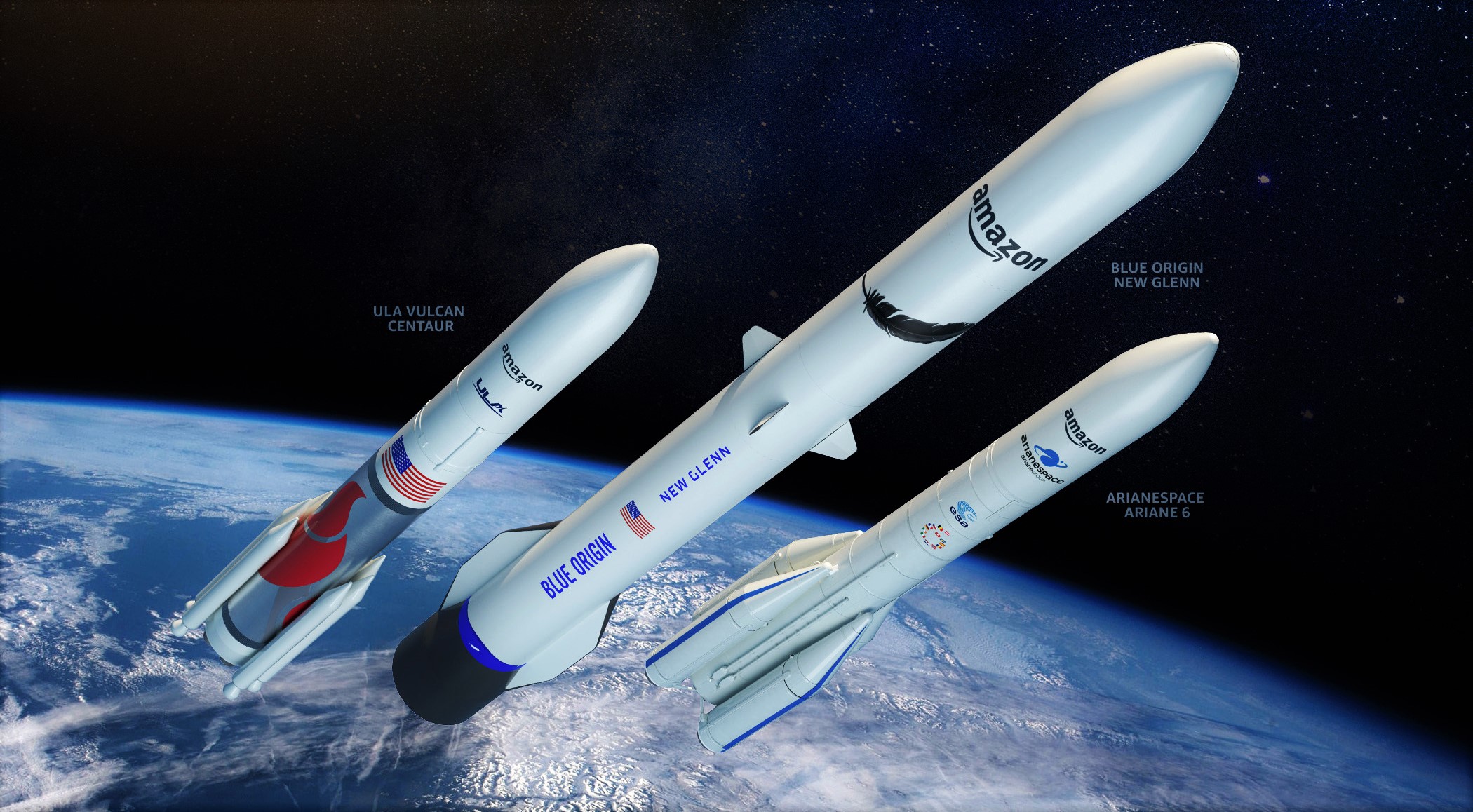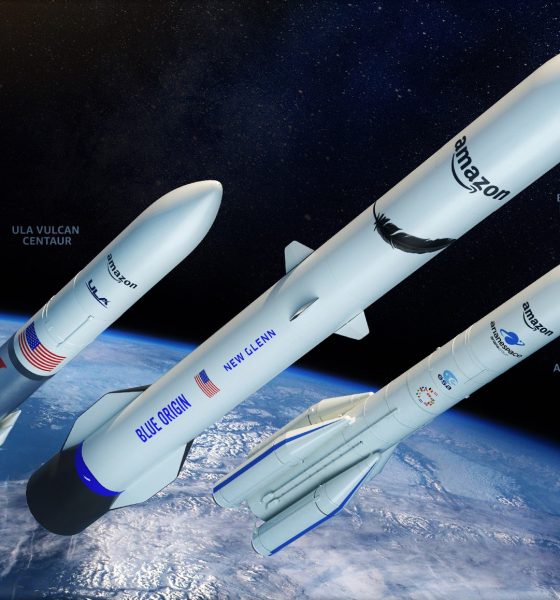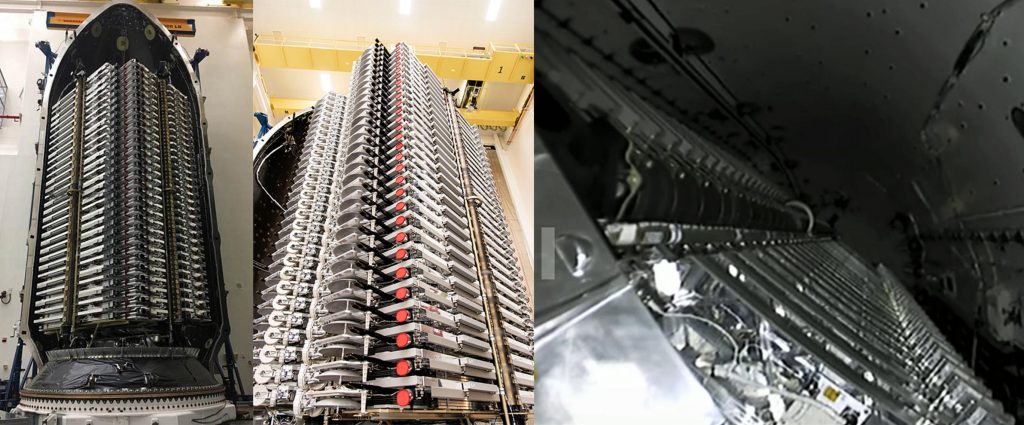

News
SpaceX still an option for future Amazon internet satellite launches, says Senior VP
An Amazon executive says that the company could still call on SpaceX to launch some of its Project Kuiper internet satellites after two of the three unproven rockets it purchased announced launch delays days apart.
Amazon began work on Project Kuiper in 2018. When SpaceX CEO Elon Musk fired several senior employees overseeing the company’s Starlink satellite internet program for being overly cautious, at least two of those employees immediately landed in senior positions at Project Kuiper. Four years later and more than two years after Amazon received an FCC license to deploy its 3,236-satellite Project Kuiper constellation, which aims to compete directly with SpaceX’s Starlink, the company’s first prototype satellite launch has changed rockets and slipped from late 2022 to early 2023.
Of the 77 firm launch contracts Amazon has signed since April 2021, only nine are for a rocket – United Launch Alliance’s (ULA) Atlas V – that has already successfully flown. The remaining 68 (and another 15 exercisable options) are spread among ULA’s Vulcan Centaur, Arianespace’s Ariane 6, and Blue Origin’s New Glenn, all of which are months away from their first launch attempts.
On October 10th, ULA CEO Tory Bruno told reporters that Vulcan Centaur’s launch debut had slipped from its latest late-2022 target to no earlier than (NET) “early 2023.” Garnering 38 of 77 firm contracts, Vulcan is the single most important rocket for Amazon’s Project Kuiper plans and is likely expected to launch close to half of all Kuiper satellites.
Nine days later, Ariane Group and the European Space Agency (ESA) announced that Ariane 6’s launch debut had also slipped from a late-2022 target. Unlike Vulcan’s gentle early-2023 slip, Ariane 6’s debut was pushed to late 2023 at the earliest, and ESA and Ariane officials frankly admitted that that could easily become 2024. Excluding options, Ariane 6 won 18 Project Kuiper launch contracts and is the constellation’s second most important rocket.
Because Amazon applied for its Project Kuiper license so early, a six-year countdown started when the FCC approved its license in July 2020. If Amazon fails to launch half of its 3,236 satellites within six years of that receipt, the FCC could revoke Kuiper’s constellation license. While it’s unlikely that the FCC would actually revoke the license of a constellation that’s close to achieving its deployment milestones, the deadline still emphasizes just how far Amazon and its suppliers are falling behind.
Vulcan, Ariane 6, and Project Kuiper prototype launch delays have only worsened an already challenging situation. In addition to the rocket’s long-awaited debut, ULA has major obligations to NASA and the US military, who expect Vulcan to complete up to four more launches in 2023. Unless ULA pulls off a minor miracle, it’s unlikely that Vulcan will be able to launch five times in its first year of service. Respectively, ULA’s Atlas V and Delta IV rockets took 2.5 and 3.5 years to reach that milestone. If ULA’s past record serves as a reasonable guide for its future, it’s possible that Vulcan Centaur won’t have the spare capacity to begin Project Kuiper launches until 2025.
The same is arguably true for Ariane 6, which has an even busier manifest – all of which may be delayed to 2024. Of Arianespace’s two most recent rockets, Ariane 4 took 14 months and Ariane 5 took 53 months to complete their first five fully successful launches. Ariane 6 borrows heavily from Ariane 5’s design. Unless Arianespace gets off to a record-breaking start or prioritizes Amazon over ESA and other European operators, an almost unthinkable scenario, it’s difficult to imagine that Ariane 6 will have the spare capacity to begin Project Kuiper launches before 2025 or 2026.
Blue Origin’s New Glenn rocket, which is years behind schedule and unlikely to debut before late 2023 or 2024, might ironically be Amazon’s best bet for the first dedicated Project Kuiper launch, but only if its debut is near-flawless and doesn’t slip any further. Given that New Glenn will be Blue Origin’s first orbital rocket of any kind, more delays and issues (if not an outright failure) on the first launch are likely. New Glenn is thus also unlikely to be ready to launch large batches of Project Kuiper satellites until 2024 or 2025. Given the record of its suborbital New Shepard rocket, the odds are also against Blue Origin quickly ramping up the cadence of a far more complex orbital launch vehicle.
Only Atlas V appears to have any significant chance of beginning large-scale Project Kuiper launches before 2025. But ULA is shutting down Atlas V production to transition to Vulcan, so it’s impossible for Amazon to order more than nine of the rockets, as ULA.
Unfortunately for Amazon, in addition to the many rocket-side issues facing Project Kuiper, its satellite prototype delays will make it even harder for the company to begin large-scale launches sooner than later. SpaceX, now the proud owner of a majority of all working satellites in orbit, took around 21 months to go from launching its first two prototypes to its first batch of 60 operational Starlink satellites. The satellite design it settled on was almost nothing like the first two prototypes.

If Amazon’s first prototypes launch on Vulcan’s early-2023 debut, perform excellently, meet or exceed expectations after just a few months of testing, and are close to the final satellite design, Project Kuiper may still have a shot at manufacturing enough satellites to fill one or more launches in 2024. But if its first satellites run into major issues, Amazon’s decision to “[bring] up manufacturing of…production satellites [in parallel with prototype development]” could set it back months if it’s forced to redesign its satellites, find new suppliers, or significantly change the factory it’s already building.
Combined, Project Kuiper finds itself in an unenviable position. It’s thus unsurprising that as of October 2022, an Amazon executive appears to have changed their tune about using SpaceX rockets. Over the last ~13 months, SpaceX has become the single most productive launch provider in the world, besting the entire nation of China. On a quarterly basis, SpaceX now launches more useful mass to orbit than the rest of the world combined. It’s also the only launch provider on Earth that can create spare capacity for last-minute customers by shuffling its own internal launch demands.
According to Dave Limp, senior vice president of devices and services at Amazon, Project Kuiper is willing to consider taking advantage of some of SpaceX’s unprecedented capabilities after it shunned the company entirely in earlier contracts and statements. Speaking in a Washington Post Live interview, Limp says that Amazon is “open to contracting with anyone” and understands “that heavy launch capacity is [and will likely remain] pretty constrained” for years to come.
Unfortunately, Limp began by falsely asserting that Falcon 9 was too small to have warranted earlier launch contracts, stating that it’s “probably at the low end of…the capacity that we need.” In an expendable configuration, Falcon 9 can launch more than 22 tons (~48,500 lb) to low Earth orbit (LEO), while Ariane 6 is quoted at [PDF] 21.7 tons (~47,800 lb). While it hasn’t flown, SpaceX also offers an extended payload fairing that should more or less match Vulcan and Ariane 6’s largest fairings.
But Limp expressed interest in SpaceX’s Falcon Heavy rocket, which could likely match or come close to the payload volume of Ariane 6 and Vulcan and far exceed either rocket’s performance to LEO. In a configuration that would allow SpaceX to recover all three of Falcon Heavy’s boosters, almost guaranteeing that it would cost less than Vulcan or Ariane 6, the rocket would likely be able to launch around 40-50 tons (90,000-110,000 lb) to LEO. The Amazon executive even brought up SpaceX’s next-generation Starship rocket as a more desirable option for future Project Kuiper launches. Starship is designed to launch anywhere from 100 to 150 tons to LEO, should cost even less than Falcon 9 or Falcon Heavy, and will eventually feature a payload bay that dwarfs even New Glenn’s massive fairing.
Nonetheless, despite the promise of SpaceX, Amazon appears to be in no rush to hedge its bets on Vulcan, Ariane 6, and New Glenn. Only time will tell if its multi-billion-dollar gamble pays off.

Elon Musk
Elon Musk’s X will start using a Tesla-like software update strategy
The initiative seems designed to accelerate updates to the social media platform, while maintaining maximum transparency.

Elon Musk’s social media platform X will adopt a Tesla-esque approach to software updates for its algorithm.
The initiative seems designed to accelerate updates to the social media platform, while maintaining maximum transparency.
X’s updates to its updates
As per Musk in a post on X, the social media company will be making a new algorithm to determine what organic and advertising posts are recommended to users. These updates would then be repeated every four weeks.
“We will make the new 𝕏 algorithm, including all code used to determine what organic and advertising posts are recommended to users, open source in 7 days. This will be repeated every 4 weeks, with comprehensive developer notes, to help you understand what changed,” Musk wrote in his post.
The initiative somewhat mirrors Tesla’s over-the-air update model, where vehicle software is regularly refined and pushed to users with detailed release notes. This should allow users to better understand the details of X’s every update and foster a healthy feedback loop for the social media platform.
xAI and X
X, formerly Twitter, has been acquired by Elon Musk’s artificial intelligence startup, xAI last year. Since then, xAI has seen a rapid rise in valuation. Following the company’s the company’s upsized $20 billion Series E funding round, estimates now suggest that xAI is worth tens about $230 to $235 billion. That’s several times larger than Tesla when Elon Musk received his controversial 2018 CEO Performance Award.
As per xAI, the Series E funding round attracted a diverse group of investors, including Valor Equity Partners, Stepstone Group, Fidelity Management & Research Company, Qatar Investment Authority, MGX, and Baron Capital Group, among others. Strategic partners NVIDIA and Cisco Investments also continued support for building the world’s largest GPU clusters.
News
Tesla FSD Supervised wins MotorTrend’s Best Driver Assistance Award
The decision marks a notable reversal for the publication from prior years, with judges citing major real-world improvements that pushed Tesla’s latest FSD software ahead of every competing ADAS system.

Tesla’s Full Self-Driving (Supervised) system has been named the best driver-assistance technology on the market, earning top honors at the 2026 MotorTrend Best Tech Awards.
The decision marks a notable reversal for the publication from prior years, with judges citing major real-world improvements that pushed Tesla’s latest FSD software ahead of every competing ADAS system. And it wasn’t even close.
MotorTrend reverses course
MotorTrend awarded Tesla FSD (Supervised) its 2026 Best Tech Driver Assistance title after extensive testing of the latest v14 software. The publication acknowledged that it had previously criticized earlier versions of FSD for erratic behavior and near-miss incidents, ultimately favoring rivals such as GM’s Super Cruise in earlier evaluations.
According to MotorTrend, the newest iteration of FSD resolved many of those shortcomings. Testers said v14 showed far smoother behavior in complex urban scenarios, including unprotected left turns, traffic circles, emergency vehicles, and dense city streets. While the system still requires constant driver supervision, judges concluded that no other advanced driver-assistance system currently matches its breadth of capability.
Unlike rival systems that rely on combinations of cameras, radar, lidar, and mapped highways, Tesla’s FSD operates using a camera-only approach and is capable of driving on city streets, rural roads, and freeways. MotorTrend stated that pure utility, the ability to handle nearly all road types, ultimately separated FSD from competitors like Ford BlueCruise, GM Super Cruise, and BMW’s Highway Assistant.
High cost and high capability
MotorTrend also addressed FSD’s pricing, which remains significantly higher than rival systems. Tesla currently charges $8,000 for a one-time purchase or $99 per month for a subscription, compared with far lower upfront and subscription costs from other automakers. The publication noted that the premium is justified given FSD’s unmatched scope and continuous software evolution.
Safety remained a central focus of the evaluation. While testers reported collision-free operation over thousands of miles, they noted ongoing concerns around FSD’s configurable driving modes, including options that allow aggressive driving and speeds beyond posted limits. MotorTrend emphasized that, like all Level 2 systems, FSD still depends on a fully attentive human driver at all times.
Despite those caveats, the publication concluded that Tesla’s rapid software progress fundamentally reshaped the competitive landscape. For drivers seeking the most capable hands-on driver-assistance system available today, MotorTrend concluded Tesla FSD (Supervised) now stands alone at the top.
News
Elon Musk’s Grokipedia surges to 5.6M articles, almost 79% of English Wikipedia
The explosive growth marks a major milestone for the AI-powered online encyclopedia, which was launched by Elon Musk’s xAI just months ago.

Elon Musk’s Grokipedia has grown to an impressive 5,615,201 articles as of today, closing in on 79% of the English Wikipedia’s current total of 7,119,376 articles.
The explosive growth marks a major milestone for the AI-powered online encyclopedia, which was launched by Elon Musk’s xAI just months ago. Needless to say, it would only be a matter of time before Grokipedia exceeds English Wikipedia in sheer volume.
Grokipedia’s rapid growth
xAI’s vision for Grokipedia emphasizes neutrality, while Grok’s reasoning capabilities allow for fast drafting and fact-checking. When Elon Musk announced the initiative in late September 2025, he noted that Grokipedia would be an improvement to Wikipedia because it would be designed to avoid bias.
At the time, Musk noted that Grokipedia “is a necessary step towards the xAI goal of understanding the Universe.”
Grokipedia was launched in late October, and while xAI was careful to list it only as Version 0.1 at the time, the online encyclopedia immediately earned praise. Wikipedia co-founder Larry Sanger highlighted the project’s innovative approach, noting how it leverages AI to fill knowledge gaps and enable rapid updates. Netizens also observed how Grokipedia tends to present articles in a more objective manner compared to Wikipedia, which is edited by humans.
Elon Musk’s ambitious plans
With 5,615,201 total articles, Grokipedia has now grown to almost 79% of English Wikipedia’s article base. This is incredibly quick, though Grokipedia remains text-only for now. xAI, for its part, has now updated the online encyclopedia’s iteration to v0.2.
Elon Musk has shared bold ideas for Grokipedia, including sending a record of the entire knowledge base to space as part of xAI’s mission to preserve and expand human understanding. At some point, Musk stated that Grokipedia will be renamed to Encyclopedia Galactica, and it will be sent to the cosmos.
“When Grokipedia is good enough (long way to go), we will change the name to Encyclopedia Galactica. It will be an open source distillation of all knowledge, including audio, images and video. Join xAI to help build the sci-fi version of the Library of Alexandria!” Musk wrote, adding in a later post that “Copies will be etched in stone and sent to the Moon, Mars and beyond. This time, it will not be lost.”








